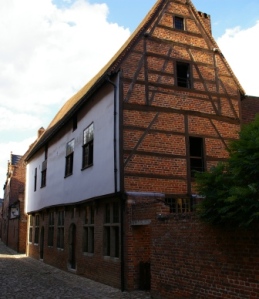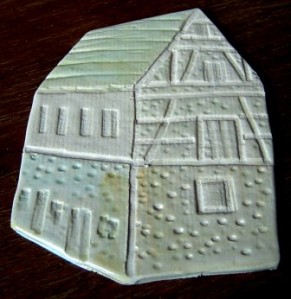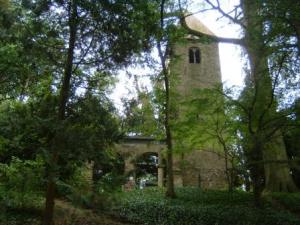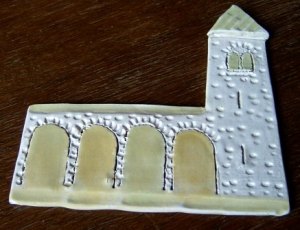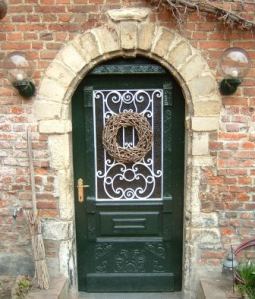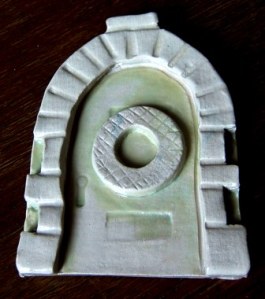 Most people have been in this place before: You obsess over some particular subject/object/person and they keep appearing before your eyes. Only, typically, what you think you see is not what is actually before you.
Most people have been in this place before: You obsess over some particular subject/object/person and they keep appearing before your eyes. Only, typically, what you think you see is not what is actually before you.
In a twist on this, I have discovered that Godfrey is everywhere. To refresh the memories of those whom I have not dulled into a stupor with endless yammering, Godfrey of Bouillon is the subject of the book that I am writing. It is a novel, but based on the lives a several real people, including Godfrey himself. Although work proceeds slowly, I do think about it a lot. When I am not actually writing or reading through medieval history, in my head I replay scenes, untangle unnecessarily complicated sections and develop dialogue.
In the last few weeks, however, I have become eerily aware that my characters keep getting up and walking out of my head and onto the street in front of me. Here in Belgium, a Godfrey statue in Brussels or certainly Bouillon is expected. But he keeps showing up elsewhere as well.
 In Rome, at the Vatican Museum, I was diligently reading through the Blue Guide descriptions of the Raphael Stanze and Loggia when Godfrey waved hello, sitting beside Ethelwulf of England — as well as a few tourists.
In Rome, at the Vatican Museum, I was diligently reading through the Blue Guide descriptions of the Raphael Stanze and Loggia when Godfrey waved hello, sitting beside Ethelwulf of England — as well as a few tourists.
But it is not just Godfrey who keeps popping into my life; other characters are making unexpected appearances.
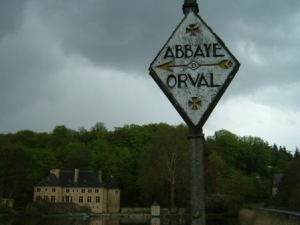 In the ruins of the Orval Abbey, I stepped up to one of the explanatory tables to read about the abbey myth of the lady, her ring and a fish. The story I knew already from the logo on the Orval beer bottle: a fish with a ring in its mouth. Evidently this unnaturally thoughtful trout delivered the ring back to the lady after she dropped it in the spring. There before me was the so-called spring (still used to feed the revered brown bottles of Orval brew) and the place where, upon receiving her ring back, Mathilda, declared that the waters must be sacred indeed and . . . Wait. That Mathilda? As in the daughter of the evil stepmother to Godfrey and the one who is married off to his hunchback uncle? Yes, indeed. And Mathilda waves hello.
In the ruins of the Orval Abbey, I stepped up to one of the explanatory tables to read about the abbey myth of the lady, her ring and a fish. The story I knew already from the logo on the Orval beer bottle: a fish with a ring in its mouth. Evidently this unnaturally thoughtful trout delivered the ring back to the lady after she dropped it in the spring. There before me was the so-called spring (still used to feed the revered brown bottles of Orval brew) and the place where, upon receiving her ring back, Mathilda, declared that the waters must be sacred indeed and . . . Wait. That Mathilda? As in the daughter of the evil stepmother to Godfrey and the one who is married off to his hunchback uncle? Yes, indeed. And Mathilda waves hello.
 Then, last night, we were watching Indiana Jones and the Last Crusade, so that I could point out to a certain non-aficionado where the Venice square in which we sipped cappuccino appears in the film. The Jones boys have escaped Brunwald Castle when Dr. Jones, Sr. explains the threat of holy grail booby traps.
Then, last night, we were watching Indiana Jones and the Last Crusade, so that I could point out to a certain non-aficionado where the Venice square in which we sipped cappuccino appears in the film. The Jones boys have escaped Brunwald Castle when Dr. Jones, Sr. explains the threat of holy grail booby traps.
But I found the clues that will safely take us through, in the Chronicles of St. Anselm.
I am pretty sure Anselm was not writing choose-your-own-adventure material back in the Middle Ages. He was, however, corresponding with a certain Ida, Countess of Boulogne, also known as the mother of Godfrey of Bouillon. In my own novelization of his achievements I have him gliding in at the right moment to help save the day, not that far off from writing clues to hidden treasures.
“Hello!” Anselm hails me from the screen.
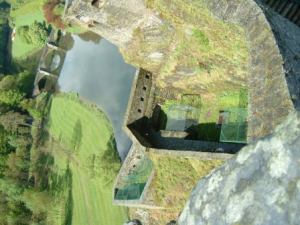 Somehow this journey has come to an end. Although we have ahead of us several weeks’ experiment in unplanned holiday-making in France, our time in Belgium is essentially up. And it would not seem right to end In Belgium, in France.
Somehow this journey has come to an end. Although we have ahead of us several weeks’ experiment in unplanned holiday-making in France, our time in Belgium is essentially up. And it would not seem right to end In Belgium, in France.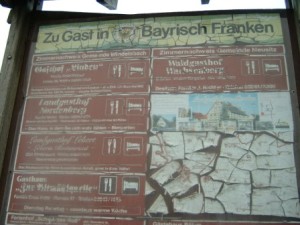
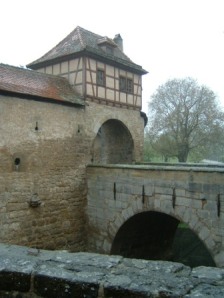
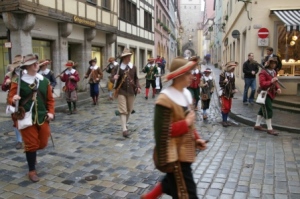
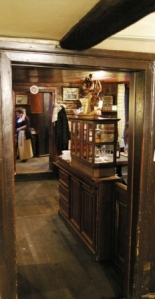
 Most people have been in this place before: You obsess over some particular subject/object/person and they keep appearing before your eyes. Only, typically, what you think you see is not what is actually before you.
Most people have been in this place before: You obsess over some particular subject/object/person and they keep appearing before your eyes. Only, typically, what you think you see is not what is actually before you. In Rome, at the Vatican Museum, I was diligently reading through the Blue Guide descriptions of the Raphael Stanze and Loggia when Godfrey waved hello, sitting beside Ethelwulf of England — as well as a few tourists.
In Rome, at the Vatican Museum, I was diligently reading through the Blue Guide descriptions of the Raphael Stanze and Loggia when Godfrey waved hello, sitting beside Ethelwulf of England — as well as a few tourists. In the ruins of the Orval Abbey, I stepped up to one of the explanatory tables to read about the abbey myth of the lady, her ring and a fish. The story I knew already from the logo on the Orval beer bottle: a fish with a ring in its mouth. Evidently this unnaturally thoughtful trout delivered the ring back to the lady after she dropped it in the spring. There before me was the so-called spring (still used to feed the revered brown bottles of Orval brew) and the place where, upon receiving her ring back, Mathilda, declared that the waters must be sacred indeed and . . . Wait. That Mathilda? As in the daughter of the evil stepmother to Godfrey and the one who is married off to his hunchback uncle? Yes, indeed. And Mathilda waves hello.
In the ruins of the Orval Abbey, I stepped up to one of the explanatory tables to read about the abbey myth of the lady, her ring and a fish. The story I knew already from the logo on the Orval beer bottle: a fish with a ring in its mouth. Evidently this unnaturally thoughtful trout delivered the ring back to the lady after she dropped it in the spring. There before me was the so-called spring (still used to feed the revered brown bottles of Orval brew) and the place where, upon receiving her ring back, Mathilda, declared that the waters must be sacred indeed and . . . Wait. That Mathilda? As in the daughter of the evil stepmother to Godfrey and the one who is married off to his hunchback uncle? Yes, indeed. And Mathilda waves hello. Then, last night, we were watching Indiana Jones and the Last Crusade, so that I could point out to a certain non-aficionado where the Venice square in which we sipped cappuccino appears in the film. The Jones boys have escaped Brunwald Castle when Dr. Jones, Sr. explains the threat of holy grail booby traps.
Then, last night, we were watching Indiana Jones and the Last Crusade, so that I could point out to a certain non-aficionado where the Venice square in which we sipped cappuccino appears in the film. The Jones boys have escaped Brunwald Castle when Dr. Jones, Sr. explains the threat of holy grail booby traps.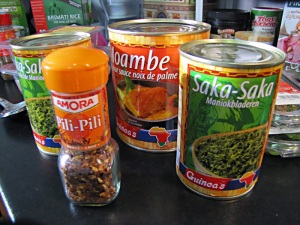 Belgian cuisine typically evokes images of frites and mussels, waffles and chocolate. Less commonly does the visitor think of the international suggestions on a potential Belgian menu, suggestions that come from far further than France or Germany.
Belgian cuisine typically evokes images of frites and mussels, waffles and chocolate. Less commonly does the visitor think of the international suggestions on a potential Belgian menu, suggestions that come from far further than France or Germany.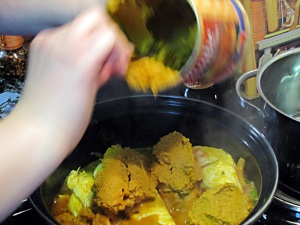 childhood. Fortunate for me, this takes the form of a Congolese meal of moambe, broiled bananas, sauteed manioc leaves and rice. The main dish consists of chicken stewed with onions in a spiced palm oil. (
childhood. Fortunate for me, this takes the form of a Congolese meal of moambe, broiled bananas, sauteed manioc leaves and rice. The main dish consists of chicken stewed with onions in a spiced palm oil. (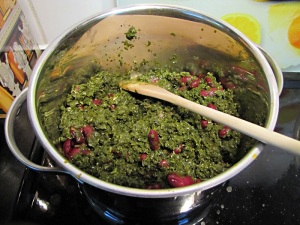 hearty dose of boiling eliminates the toxins, and a handy prepared can of the vegetable alleviates the need (and evidently foul odor) of having to do that yourself.
hearty dose of boiling eliminates the toxins, and a handy prepared can of the vegetable alleviates the need (and evidently foul odor) of having to do that yourself.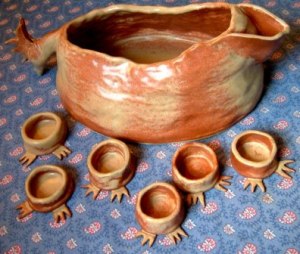 The clay class
The clay class